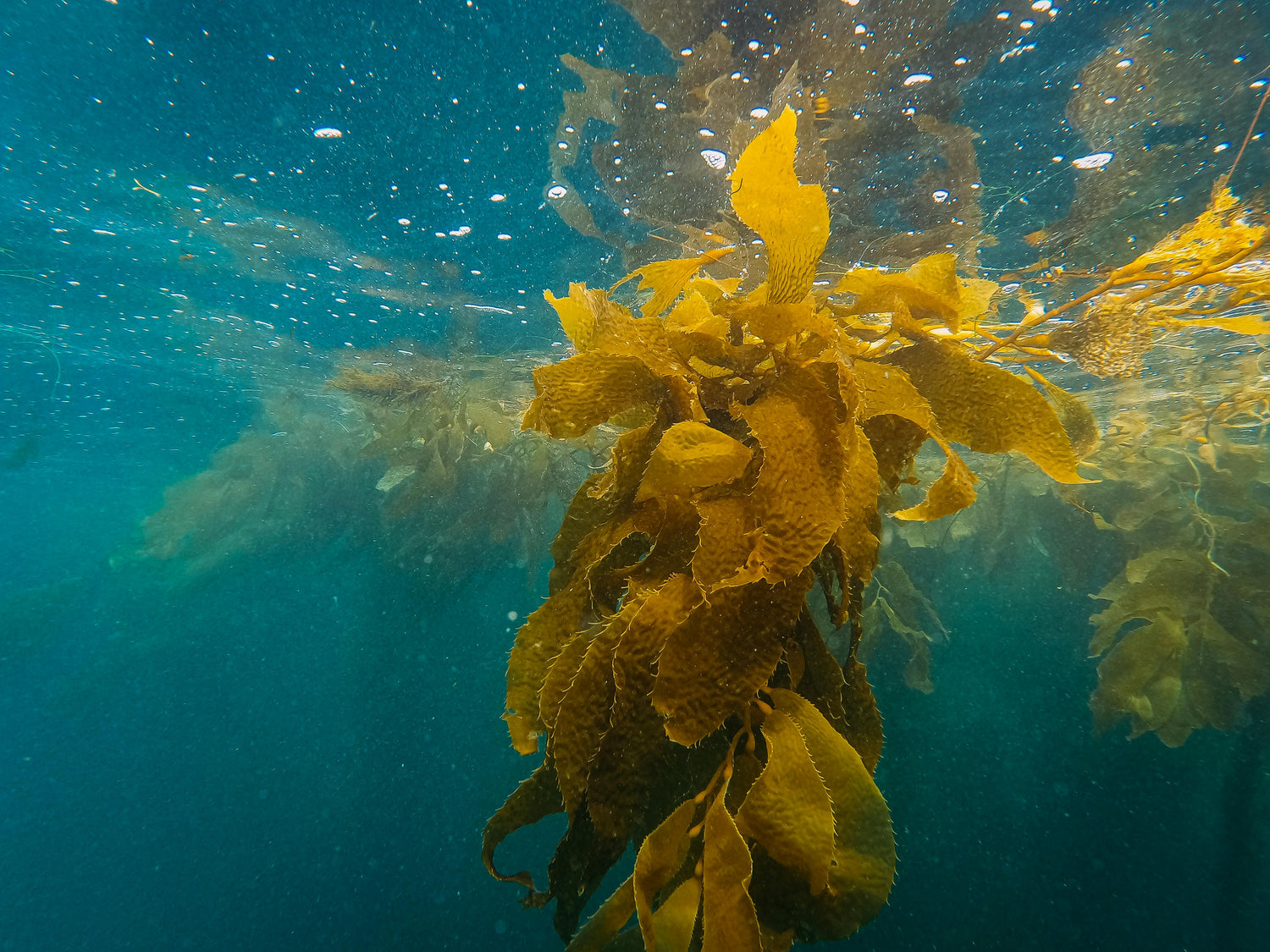
DHA & EPA Algenöl
Herkunft und Geschichte:
Docosahexaensäure (DHA) und Eicosapentaensäure (EPA) zählen zu den mehrfach ungesättigten Omega-3-Fettsäuren, die für den Körper direkt verfügbar sind. Omega-3-Fettsäuren müssen aus der Nahrung aufgenommen werden, da unser Körper diese nicht selbst herstellen kann, jedoch für den Stoffwechsel und Zellbau dringend benötigt. EPA ist für unseren Körper eine Vorstufe von DHA. Entgegen der ursprünglichen Formulierung ist EPA nicht nur und keine direkte Vorstufe von DHA, sondern beide Fettsäuren erfüllen eigenständige Funktionen im Körper Diese Fettsäuren sind normalerweise in größeren Mengen in fetthaltigen Fischprodukten wie Lachs enthalten. Eine von uns verwendete vegane Alternative ist die Gewinnung der Fettsäuren aus Algen.
Eigenschaften:
Die lebenswichtigen Bausteine für unseren Körper sind nötig für einen gesunden Stoffwechsel und eine gesunde Entwicklung des Hirns. Nötig sind sie spezifischer in einer Anzahl unterschiedlicher Aufgaben wie beispielsweise die Regulation der Blutfettwerte und Entzündungsreaktionen, die Hormonproduktion und Bildung der Zellmembranen. DHA ist die am häufigsten vorkommende Omega-3-Fettsäure im zentralen Nervensystem aufgrund seiner essenziellen Funktionen in diesem Bereich. Nicht nur für den Sehprozess, auch für die Signalweiterleitung im Nervensystem wird es benötigt. Da es besonders wichtig bei der Hirnbildung ist wird daher Schwangeren eine ausreichende DHA-Versorgung nahegelegt.
Von der Europäischen Behörde für Lebensmittelsicherheit (EFSA) sind durch wissenschaftliche Studien folgende DHA/EPA bezogene gesundheitliche Angaben bewertet und zugelassen bei einer täglichen Aufnahme von 250 mg DHA/EPA:
-
DHA trägt zur Erhaltung einer normalen Gehirnfunktion bei
-
DHA trägt zur Erhaltung normaler Sehkraft bei
-
EPA und DHA tragen zu einer normalen Herzfunktion bei
Die Kombination von DHA/EPA steht schon länger im Gespräch, potenziell das Risiko für Herz-Kreislauf-Erkrankungen zu verringern. In mehreren Studien wurde dabei eine höhere Aufnahme der Fettsäuren mit einer geringeren Sterblichkeit bei kardiovaskulären Erkrankungen assoziiert und es wird von einer Rolle bei der Prävention ausgegangen. Eigenschaften die DHA/EPA besitzen, sind ein günstiger Einfluss auf den Fettstoffwechsel, die Blutdruckregulierung, die Herzfunktion und Entzündungsreaktionen. Dies zusammen kann möglicherweise das Risiko an Herz-Kreislauf-Erkrankungen senken.
Auch ein positiver Bezug zu psychologischen Erkrankungen wie Depression und neurodegenerativen Erkrankungen wie Alzheimer besteht. Eine DHA+EPA-Supplementation, so wie auch EPA allein, führte in einer Studie bei den betroffenen Probanden zu einer Verminderung depressiver Symptome. Daher wird auch eine Omega-3-Supplementation von internationalen Gesundheitsbehörden empfohlen bei Risikogruppen so wie erkrankten Kindern, Schwangeren und älteren Menschen.
Zufuhrempfehlung
Laut der Deutschen Gesellschaf für Ernährung e.V. (DGE) benötigen Schwangere und Stille eine tägliche Menge von 200 Milligramm DHA pro Tag für eine gesunde Entwicklung der Kinder. Eine allgemeine Zufuhrempfehlung mit Ausnahme für Schwangere oder Stillende, gibt es nicht.
Mögliche Nebenwirkungen
Eine Einnahme von DHA/EPA kann bei Diabetikern zu Nebenwirkungen führen, da es die Blutzuckereinstellung erschwert sowie das Immunsystem nachteilig beeinflusst. Auch der LDL-Cholesterinspiegel wird beeinflusst und kann sich erhöhen. Es ist ratsam sich vor Einnahme bei einem Arzt zu beraten. Bei älteren Menschen kann die Immunabwehr beeinträchtigt werden.
Mögliche Interaktionen
Es können Wechselwirkungen mit gerinnungshemmenden Medikamenten wie Aspirin auftreten, da höhere DHA/EPA Dosierungen die Fließeigenschaft des Blutes verändern können und damit das Blutungsrisiko erhöhen können.
Bioverfügbarkeit von Algenöl
Die Bioverfügbarkeit von Algenöl steht der von Fischöl in Nichts nach. Bei vergleichenden Studien war die Fettsäureabsorption von Öl aus Algen und Fisch gleich gut und in einem ähnlichen Rahmen. Einige Studien weisen sogar auf eine möglicherweise bessere Wirksamkeit von Algenöl im Vergleich zu Thunfischöl hin, da Algenöl eine nachhaltigere, längerfristige Freisetzung und eine höhere Verdaulichkeit im Darm zeigte.
Die Algenkultivierung
Die Kultivierung von Algen kann auf drei verschiedene Arten erfolgen. Zum einen gibt es offene Becken, in denen die Algen kultiviert werden können, oder geschlossene Bioreaktoren. Bei den Bioreaktoren gibt es zwei verschiedene Arten, die Photobioreaktoren, die konstantes Licht als Energie für die Kultivierung nutzen und somit Strom für die Beleuchtung verbrauchen, und die heterotrophen Bioreaktoren, die Kohlenstoffquellen als Energie nutzen und somit Energie für einen konstanten Gasaustausch verbrauchen, jedoch eine höhere Biomasse ermöglichen.
Algenöl und Umwelt
Der ständige Bedarf an Fischen wegen ihres einzigartigen Nährwerts, wie z. B. Omega-3-Fettsäuren, führt dazu, dass die Fischbestände pro Jahr auf ein Maximum ansteigen, um die Fische für den menschlichen Verzehr zu versorgen was sich erheblich auf die Fischbestände auswirkt und die Möglichkeit des Aussterbens zur Folge hat. Die Versorgung der benötigten Aquakulturen geht einher mit Meeresverschmutzungen durch Chemikalien, Antibiotika und kaputten Netzkäfigen. Algenöl verbraucht zwar Energie wie beispielsweise Strom, um die Algen in meistens Bioreaktoren zu züchten, im Allgemeinen ist es jedoch eine umweltfreundlichere Alternative zu den meisten Fischquellen. Die Fähigkeit der Algen, CO2 zu binden, trägt zu ihrer Nachhaltigkeit bei, indem sie hilft, den Kohlenstoff-Fußabdruck ihrer Produktion zu verringern. Darüber hinaus können Algen auf nicht landwirtschaftlich nutzbarem Boden unter Verwendung von nicht trinkbarem Wasser (einschließlich Brack- oder Meerwasser) produziert werden. Da Algen dicht wachsen können wurde in einer Studie gezeigt, dass Algen jährlich 167-mal mehr nützliche Biomasse produzieren können als Mais, wenn sie dieselbe Fläche nutzen.
Welche AgilNature® Produkte enthalten DHA und EPA Algenöl?
|
Produkt |
Menge |
NRV* |
|
Omega3Agil |
962,7 mg pro Tagesration (à 3 Kapseln) |
** |
*Nutrient Reference Value = Prozentsatz des Referenzwertes nach Anlage XIII der Lebensmittelinformationsverordnung VO (EG) Nr. 1169/2011.
** Keine Empfehlung vorhanden.
Literatur:
-
Ist Algenöl eine pflanzliche Alternative für Omega-3-Fettsäuren? | Verbraucherzentrale.de. Verbraucherzentrale.de. https://www.verbraucherzentrale.de/wissen/lebensmittel/gesund-ernaehren/ist-algenoel-eine-pflanzliche-alternative-fuer-omega3fettsaeuren-51990 (abgerufen am 12.02.2024)
-
Fett, essenzielle Fettsäuren. DGE. https://www.dge.de/wissenschaft/referenzwerte/fett-essenzielle-fettsaeuren/ (abgerufen am 12.02.2024)
-
BfR: Für die Anreicherung von Lebensmitteln mit Omega-3-Fettsäuren empfiehlt das BfR die Festsetzung von Höchstmengen Stellungnahme Nr. 030/2009 des BfR vom 26. Mai 2009. (abgerufen am 15.02.2024)
-
Rehberg, C. (2023, August 4). Omega 3 - Die Wirkung der Fettsäuren. Zentrum Der Gesundheit. https://www.zentrum-der-gesundheit.de/ernaehrung/nahrungsergaenzung/omega-3-uebersicht/omega-3 (abgerufen am 15.02.2024)
-
Djuricic I, Calder PC. Beneficial Outcomes of Omega-6 and Omega-3 Polyunsaturated Fatty Acids on Human Health: An Update for 2021. Nutrients. 2021 Jul 15;13(7):2421.
-
Kelsey MD, Pagidipati NJ. Should We "RESPECT EPA" More Now? EPA and DHA for Cardiovascular Risk Reduction. Curr Cardiol Rep. 2023 Nov;25(11):1601-1609.
-
Elagizi A, Lavie CJ, O'Keefe E, Marshall K, O'Keefe JH, Milani RV. An Update on Omega-3 Polyunsaturated Fatty Acids and Cardiovascular Health. Nutrients. 2021 Jan 12;13(1):204.
-
Wang X, Xiao A, Yang Y, Zhao Y, Wang CC, Wang Y, Han J, Wang Z, Wen M. DHA and EPA Prevent Seizure and Depression-Like Behavior by Inhibiting Ferroptosis and Neuroinflammation via Different Mode-of-Actions in a Pentylenetetrazole-Induced Kindling Model in Mice. Mol Nutr Food Res. 2022 Nov;66(22):e2200275.
-
Peng Z, Zhang C, Yan L, Zhang Y, Yang Z, Wang J, Song C. EPA is More Effective than DHA to Improve Depression-Like Behavior, Glia Cell Dysfunction and Hippcampal Apoptosis Signaling in a Chronic Stress-Induced Rat Model of Depression. Int J Mol Sci. 2020 Mar 5;21(5):1769.
-
Kousparou C, Fyrilla M, Stephanou A, Patrikios I. DHA/EPA (Omega-3) and LA/GLA (Omega-6) as Bioactive Molecules in Neurodegenerative Diseases. Int J Mol Sci. 2023 Jun 27;24(13):10717.
-
Stiefvatter, L., Lehnert, K., Frick, K., Montoya-Arroyo, A., Frank, J., Vetter, W., Schmid-Staiger, U., & Bischoff, S. C. (2021). Oral Bioavailability of Omega-3 Fatty Acids and Carotenoids from the Microalgae Phaeodactylum tricornutum in Healthy Young Adults. Marine drugs, 19(12), 700.
-
Hu Z, Wu P, Wang L, Wu Z, Chen XD. Exploring in vitro release and digestion of commercial DHA microcapsules from algae oil and tuna oil with whey protein and casein as wall materials. Food Funct. 2022 Jan 24;13(2):978-989.
-
Lenihan-Geels G, Bishop KS, Ferguson LR. Alternative Sources of Omega-3 Fats: Can We Find a Sustainable Substitute for Fish? Nutrients. 2013; 5(4):1301-1315.
-
Diaz, C. J., Douglas, K. J., Kang, K., Kolarik, A. L., Malinovski, R., Torres-Tiji, Y., Molino, J. V., Badary, A. & Mayfield, S. P. (2023). Developing algae as a sustainable food source. Frontiers in Nutrition, 9, 1029841.

